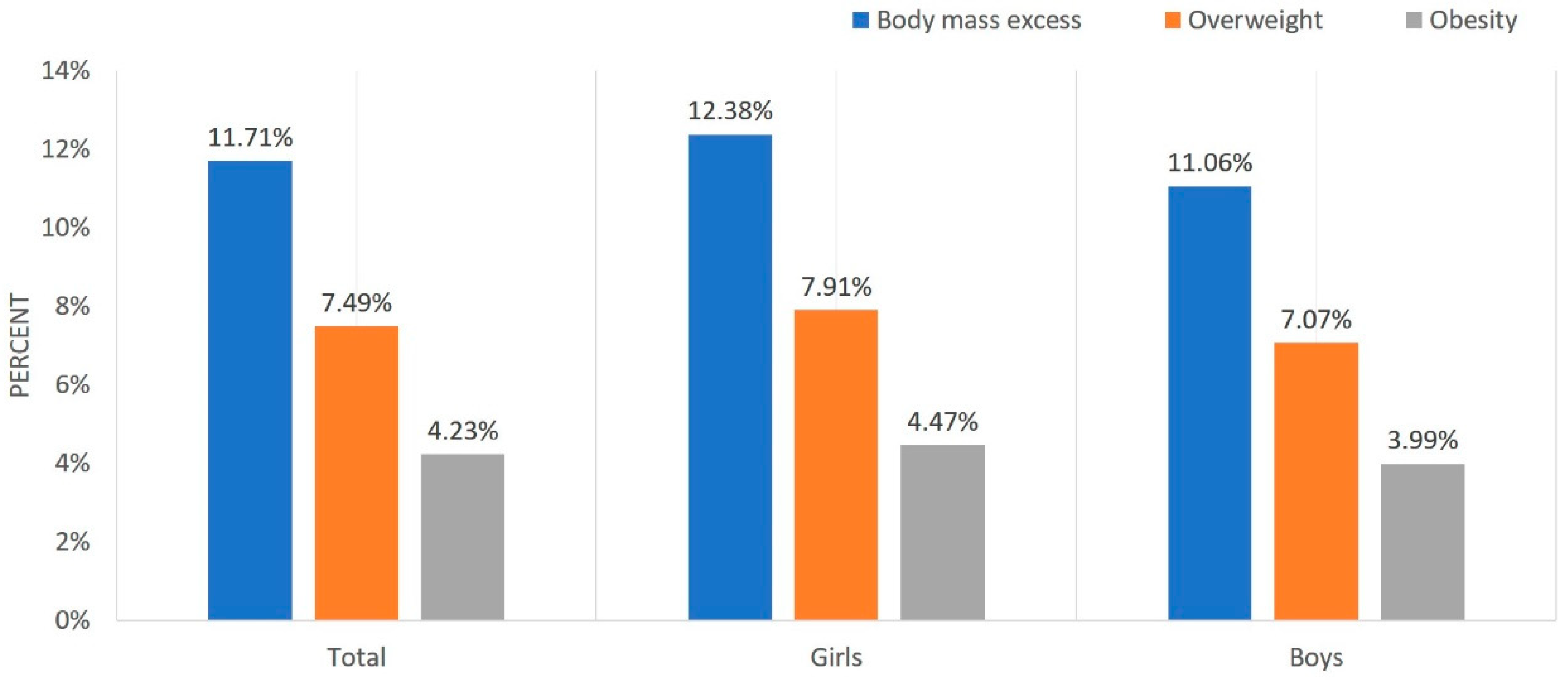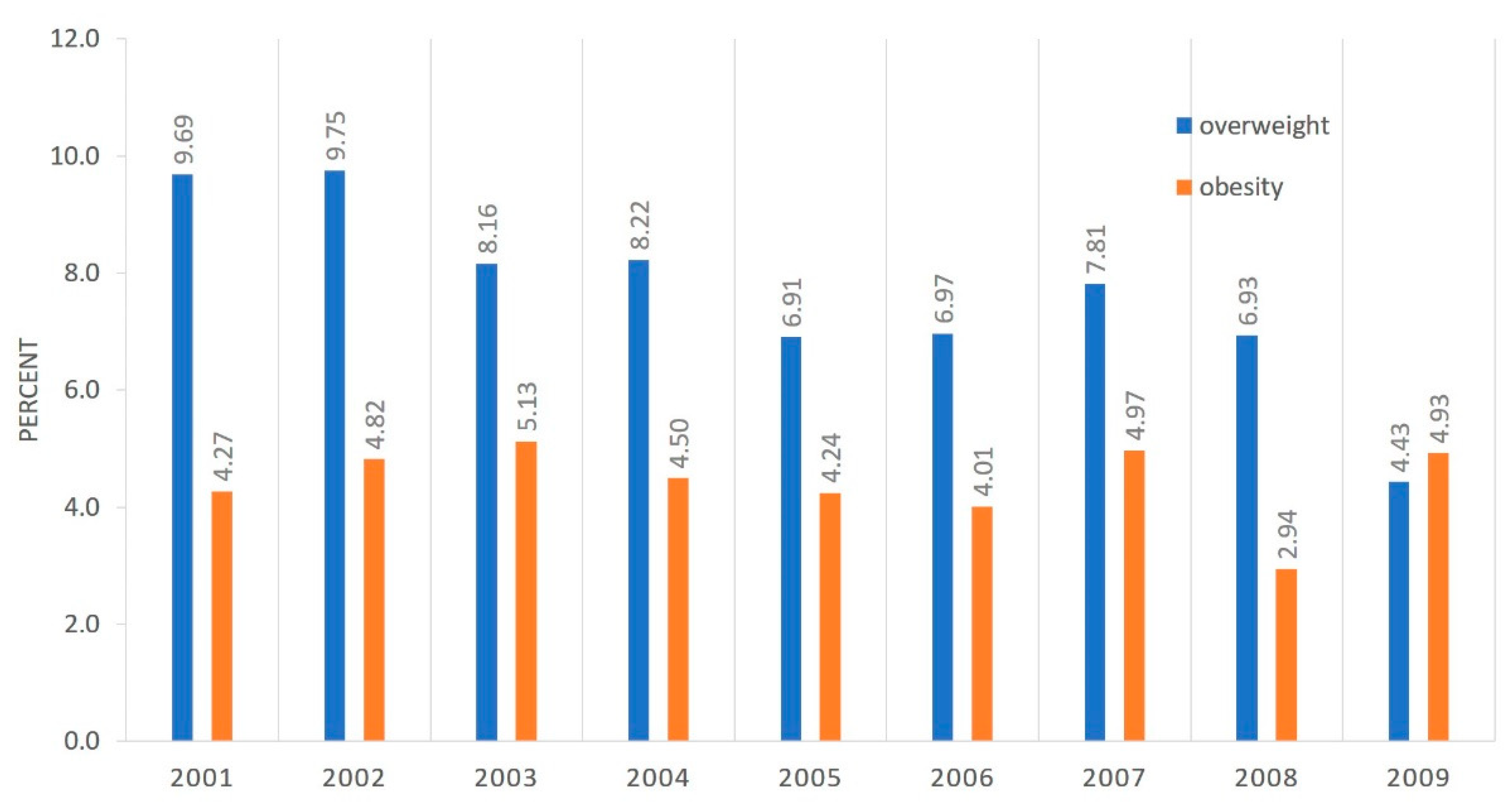Prevalence of Overweight and Obesity in 6–7-Year-Old Children—A Result of 9-Year Analysis of Big City Population in Poland
Abstract
1. Introduction
2. Materials and Methods
Ethics Approval
3. Results
4. Discussion
5. Conclusions
Author Contributions
Funding
Acknowledgments
Conflicts of Interest
References
- Simmonds, M.; Llewellyn, A.; Owen, C.G.; Woolacott, N. Predicting adult obesity from childhood obesity: A systematic review and meta-analysis. Obes. Rev. 2016, 17, 95–107. [Google Scholar] [CrossRef] [PubMed]
- Llewellyn, A.; Simmonds, M.; Owen, C.G.; Woolacott, N. Childhood obesity as a predictor of morbidity in adulthood: A systematic review and meta-analysis. Obes. Rev. 2016, 17, 56–67. [Google Scholar] [CrossRef] [PubMed]
- Abarca-Gómez, L.; Abdeen, Z.A.; Hamid, Z.A.; Abu-Rmeileh, N.M.; Acosta-Cazares, B.; Acuin, C.; Adams, R.J.; Aekplakorn, W.; Afsana, K.; Aguilar-Salinas, C.A.; et al. Worldwide trends in body-mass index, underweight, overweight, and obesity from 1975 to 2016: A pooled analysis of 2416 population-based measurement studies in 128·9 million children, adolescents, and adults. The Lancet 2017, 390, 2627–2642. [Google Scholar] [CrossRef]
- Garrido-Miguel, M.; Cavero-Redondo, I.; Álvarez-Bueno, C.; Rodríguez-Artalejo, F.; Moreno, L.A.; Ruiz, J.R.; Ahrens, W.; Martínez-Vizcaíno, V. Prevalence and Trends of Overweight and Obesity in European Children from 1999 to 2016: A Systematic Review and Meta-analysis. JAMA Pediatr. 2019, 173, e192430. [Google Scholar] [CrossRef]
- WHO. Obesity and Overweight. Available online: https://www.who.int/news-room/fact-sheets/detail/obesity-and-overweight (accessed on 10 February 2020).
- Kułaga, Z.; Litwin, M.; Tkaczyk, M.; Palczewska, I.; Zajączkowska, M.; Zwolińska, D.; Krynicki, T.; Wasilewska, A.; Moczulska, A.; Morawiec-Knysak, A.; et al. Polish 2010 growth references for school-aged children and adolescents. Eur. J. Pediatr. 2011, 170, 599–609. [Google Scholar] [CrossRef]
- Kułaga, Z.; Grajda, A.; Gurzkowska, B.; Góźdź, M.; Wojtyło, M.; Świąder, A.; Różdżyńska-Świątkowska, A.; Litwin, M. Polish 2012 growth references for preschool children. Eur. J. Pediatr. 2013, 172, 753–761. [Google Scholar] [CrossRef]
- Cole, T.J.; Bellizzi, M.C.; Flegal, K.M.; Dietz, W.H. Establishing a standard definition for child overweight and obesity worldwide: International survey. Br. Med. J. 2000, 320, 1240–1243. [Google Scholar] [CrossRef]
- De Onis, M.; Onyango, A.W.; Borghi, E.; Siyam, A.; Nishida, C.; Siekmann, J. Development of a WHO growth reference for school-aged children and adolescents. Bulletin of the World Health Organization 2007, 85, 660–667. [Google Scholar] [CrossRef]
- Kułaga, Z.; Grajda, A.; Gurzkowska, B.; Wojtyło, M.; Góźdź, M.; Litwin, M. The prevalence of overweight and obesity among Polish school- aged children and adolescents. Przegl. Epidemiol. 2016, 70, 641–651. [Google Scholar]
- Małecka-Tendera, E.; Klimek, K.; Matusik, P.; Olszanecka-Glinianowicz, M.; Lehingue, Y. Obesity and Overweight Prevalence in Polish 7- to 9-Year-Old Children. Obes. Res. 2005, 13, 964–968. [Google Scholar] [CrossRef]
- Available online: http://www.imid.med.pl/files/imid/Do%20pobrania/Raport%20COSI_kwiecie%C5%84.pdf (accessed on 16 February 2020).
- Childhood Obesity Surveillance Initiative (COSI) Factsheet. Highlights 2015-17 (2018). 2018. Available online: https://www.google.com.hk/url?sa=t&rct=j&q=&esrc=s&source=web&cd=5&ved=2ahUKEwiGw9Pt9LfpAhVhL6YKHcW5CjQQFjAEegQIAxAB&url=http%3A%2F%2Fwww.euro.who.int%2F__data%2Fassets%2Fpdf_file%2F0006%2F372426%2FWH14_COSI_factsheets_v2.pdf%3Fua%3D1&usg=AOvVaw2BzG1M7RXeLGlCNv_nyl4J (accessed on 16 February 2020).
- Chrzanowska, M.; Koziel, S.; Ulijaszek, S.J. Changes in BMI and the prevalence of overweight and obesity in children and adolescents in Cracow, Poland, 1971-2000. Econ. Hum. Biol. 2007, 5, 370–378. [Google Scholar] [CrossRef] [PubMed]
- Suder, A.; Gomula, A.; Koziel, S. Central overweight and obesity in Polish schoolchildren aged 7–18 years: Secular changes of waist circumference between 1966 and 2012. Eur. J. Pediatr. 2017, 176, 909–916. [Google Scholar] [CrossRef] [PubMed]
- Mazur, A.; Klimek, K.; Telega, G.; Filip, R.; Małecka-Tendera, E. Ten-year secular trend of overweight and obesity in school children in south-eastern Poland. Ann. Agric. Environ. Med. 2014, 21, 634–638. [Google Scholar] [CrossRef] [PubMed]
- Brzeziński, M.; Jankowski, M.; Jankowska, A.; Niedzielska, A.; Kamińska, B.; Brzeziński, M. Is there a rapid increase in prevalence of obesity in Polish children? An 18-year prospective observational study in Gdansk, Poland. Arch. Med. Sci. 2018, 14, 22–29. [Google Scholar] [CrossRef] [PubMed]
- Kozieł, S.; Kołodziej, H.; Ulijaszek, S.J. Parental education, body mass index and prevalence of obesity among 14-year-old boys between 1987 and 1997 in Wrocław, Poland. Eur. J. Epidemiol. 2000, 16, 1163–1167. [Google Scholar] [CrossRef] [PubMed]
- Freedman, D.S.; Mei, Z.; Srinivasan, S.R.; Berenson, G.S.; Dietz, W.H. Cardiovascular Risk Factors and Excess Adiposity Among Overweight Children and Adolescents: The Bogalusa Heart Study. J. Pediatr. 2007, 150, 12–17.e2. [Google Scholar] [CrossRef]
- Freedman, D.S.; Horlick, M.; Berenson, G.S. A comparison of the Slaughter skinfold-thickness equations and BMI in predicting body fatness and cardiovascular disease risk factor levels in children. Am. J. Clin. Nutr. 2013, 98, 1417–1424. [Google Scholar] [CrossRef]
- Nader, P.R.; O’Brien, M.; Houts, R.; Bradley, R.; Belsky, J.; Crosnoe, R.; Friedman, S.; Mei, Z.; Susman, E.J. Identifying risk for obesity in early childhood. Pediatrics 2006, 118, e594–e601. [Google Scholar] [CrossRef]
- Elmaogullari, S.; Demirel, F.; Hatipoglu, N. Risk factors that affect metabolic health status in obese children. J. Pediatr. Endocrinol. Metab. 2017, 30, 49–55. [Google Scholar] [CrossRef]
- Zieske, A.W.; Malcom, G.T.; Strong, J.P. Natural History And Risk Factors Of Atherosclerosis In Children And Youth: The Pday Study. Pediatr. Pathol. Mol. Med. 2002, 21, 213–237. [Google Scholar] [CrossRef]
- Brzezinski, M.; Jankowski, M.; Niedzielska, A.; Danielewicz, A.; Czarnecka, P. Health program “6-10-14 for Health” as an example of comprehensive environmental activities in the field of children obesity. Study protocol and primary results. Appetite 2014, 76, 202. [Google Scholar] [CrossRef]
- Szlagatys-Sidorkiewicz, A.; Brzeziński, M.; Jankowska, A.; Metelska, P.; Słomińska-Fraczek, M.; Socha, P. Long-term effects of vitamin D supplementation in vitamin D deficient obese children participating in an integrated weight-loss programme (a double-blind placebo-controlled study) - rationale for the study design. BMC Pediatrics 2017, 17, 97. [Google Scholar] [CrossRef] [PubMed]




| n | Mean Age ± SD | Mean Body Weight ± SD | Mean Height ± SD | Mean BMI ± SD | Mean BMI Percentile ± SD | |
|---|---|---|---|---|---|---|
| Girls | 6109 | 6.53 ± 0.38 | 23.08 ± 4.14 | 121.33 ± 5.53 | 15.56 ± 1.9 | 47.97 ± 27.42 |
| Boys | 6221 | 6.54 ± 0.38 | 23.66 ± 4.24 | 122.35 ± 5.52 | 15.72 ± 1.9 | 45.21 ± 27.03 |
| Total | 12330 | 6.53 ± 0.38 | 23.37 ± 4.2 | 121.84 ± 5.55 | 15.66 ± 1.9 | 46.58 ± 27.26 |
| Girls | n | Mean Age ± SD | Mean Body Weight ± SD | Mean Height ± SD | Mean BMI ± SD | Mean BMI Percentile ± SD |
|---|---|---|---|---|---|---|
| 2001 | 351 | 6.72 ± 0.31 | 23.68 ± 4.32 | 122.38 ± 5.42 | 15.72 ± 1.92 | 49.15 ± 27.76 |
| 2002 | 933 | 6.52 ± 0.37 | 23.26 ± 4.26 | 121.5 ± 5.48 | 15.67 ± 1.95 | 48.83 ± 27.73 |
| 2003 | 858 | 6.54 ± 0.4 | 23.22 ± 4.18 | 121.6 ± 5.88 | 15.63 ± 1.94 | 48.3 ± 27.44 |
| 2004 | 912 | 6.54 ± 0.37 | 23.19 ± 4.36 | 121.6 ± 5.56 | 15.59 ± 2 | 47.33 ± 27.67 |
| 2005 | 825 | 6.5 ± 0.37 | 22.96 ± 3.85 | 121.05 ± 5.43 | 15.6 ± 1.81 | 48.7 ± 27.43 |
| 2006 | 847 | 6.53 ± 0.38 | 22.84 ± 3.96 | 120.81 ± 5.37 | 15.57 ± 1.8 | 48.1 ± 27.02 |
| 2007 | 704 | 6.54 ± 0.37 | 23.36 ± 4.21 | 121.64 ± 5.51 | 15.71 ± 1.96 | 49.48 ± 27.45 |
| 2008 | 476 | 6.5 ± 0.38 | 22.5 ± 3.92 | 120.82 ± 5.45 | 15.34 ± 1.8 | 44.03 ± 26.55 |
| 2009 | 203 | 6.3 ± 0.32 | 22.06 ± 3.76 | 119.8 ± 4.98 | 15.3 ± 1.79 | 43.92 ± 26.91 |
| Boys | n | Mean Age ± SD | Mean Body Weight ± SD | Mean Height ± SD | Mean BMI ± SD | Mean BMI Percentile ± SD |
|---|---|---|---|---|---|---|
| 2001 | 413 | 6.71 ± 0.32 | 24.01 ± 4.6 | 123.17 ± 5.69 | 15.72 ± 1.95 | 44.43 ± 26.88 |
| 2002 | 911 | 6.51 ± 0.38 | 24.03 ± 4.47 | 122.35 ± 5.52 | 15.96 ± 2.07 | 48.32 ± 28.16 |
| 2003 | 888 | 6.55 ± 0.38 | 23.67 ± 4.14 | 122.59 ± 5.31 | 15.67 ± 1.86 | 44.68 ± 27.54 |
| 2004 | 949 | 6.53 ± 0.38 | 23.68 ± 4.46 | 122.23 ± 5.59 | 15.75 ± 1.9 | 45.29 ± 27.38 |
| 2005 | 830 | 6.55 ± 0.37 | 23.65 ± 3.9 | 122.35 ± 5.31 | 15.71 ± 1.7 | 45.51 ± 24.92 |
| 2006 | 842 | 6.53 ± 0.38 | 23.23 ± 3.85 | 121.94 ± 5.47 | 15.55 ± 1.71 | 43.41 ± 25.99 |
| 2007 | 742 | 6.53 ± 0.38 | 23.63 ± 4.11 | 122.52 ± 5.25 | 15.67 ± 1.94 | 44.47 ± 26.97 |
| 2008 | 465 | 6.51 ± 0.39 | 23.55 ± 4.22 | 122.24 ± 5.38 | 15.67 ± 1.93 | 44.53 ± 26.62 |
| 2009 | 181 | 6.33 ± 0.32 | 23.29 ± 3.91 | 121.4 ± 5.76 | 15.71 ± 1.91 | 45.4 ± 26.68 |
© 2020 by the authors. Licensee MDPI, Basel, Switzerland. This article is an open access article distributed under the terms and conditions of the Creative Commons Attribution (CC BY) license (http://creativecommons.org/licenses/by/4.0/).
Share and Cite
Szczyrska, J.; Jankowska, A.; Brzeziński, M.; Jankowski, M.; Metelska, P.; Szlagatys-Sidorkiewicz, A. Prevalence of Overweight and Obesity in 6–7-Year-Old Children—A Result of 9-Year Analysis of Big City Population in Poland. Int. J. Environ. Res. Public Health 2020, 17, 3480. https://doi.org/10.3390/ijerph17103480
Szczyrska J, Jankowska A, Brzeziński M, Jankowski M, Metelska P, Szlagatys-Sidorkiewicz A. Prevalence of Overweight and Obesity in 6–7-Year-Old Children—A Result of 9-Year Analysis of Big City Population in Poland. International Journal of Environmental Research and Public Health. 2020; 17(10):3480. https://doi.org/10.3390/ijerph17103480
Chicago/Turabian StyleSzczyrska, Joanna, Agnieszka Jankowska, Michał Brzeziński, Marek Jankowski, Paulina Metelska, and Agnieszka Szlagatys-Sidorkiewicz. 2020. "Prevalence of Overweight and Obesity in 6–7-Year-Old Children—A Result of 9-Year Analysis of Big City Population in Poland" International Journal of Environmental Research and Public Health 17, no. 10: 3480. https://doi.org/10.3390/ijerph17103480
APA StyleSzczyrska, J., Jankowska, A., Brzeziński, M., Jankowski, M., Metelska, P., & Szlagatys-Sidorkiewicz, A. (2020). Prevalence of Overweight and Obesity in 6–7-Year-Old Children—A Result of 9-Year Analysis of Big City Population in Poland. International Journal of Environmental Research and Public Health, 17(10), 3480. https://doi.org/10.3390/ijerph17103480






